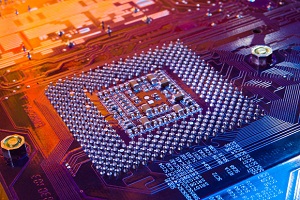
Theoretical physicist Michio Kaku believes Moore's Law has about 10 years of life left before ever-shrinking transistor sizes smack up against limitations imposed by the laws of thermodynamics and quantum physics. That day of reckoning for the computing industry may still be a few years away, but signs of the coming Moorepocalypse are already here. Just ask chip maker AMD.
 The company's Chief Product Architect John Gustafson believes AMD’s difficulties in transitioning from 28-nanometer chips to 20-nanometer silicon shows we’ve reached the beginning of the end.
The company's Chief Product Architect John Gustafson believes AMD’s difficulties in transitioning from 28-nanometer chips to 20-nanometer silicon shows we’ve reached the beginning of the end.
"You can see how Moore's Law is slowing down," Gustafson recently told the Inquirer. "We've been waiting for that transition from 28nm to 20nm to happen and it's taking longer than Moore's Law would have predicted...I'm saying you are seeing the beginning of the end of Moore's law." A processor’s nanometer measurement tells you the size of the smallest transistors on a given chip.
Doomsday predictions about the end of Moore's Law are nearly as old as the famous observation posited by Intel cofounder Gordon Moore in 1965. In his 2011 book Physics of the Future, for example, Kaku predicted the end of Moore’s Law could turn Silicon Valley into a “rust belt” if a replacement technology for silicon isn’t found.
Not just about tech
Moore's Law, Gustafson argues, wasn't just about the technological ability to put more transistors on a chip, but also the economic feasibility of doing so. "The original statement of Moore's Law is the number of transistors that is more economical to produce will double every two years," Gustafson said. "It has become warped into all these other forms but that is what he originally said."
Gustafson's comments echo similar statements another AMD representative recently told PCWorld. "Moore’s Law was always about the cost of the transistors as much as performance increasing as you could afford more and more of them," Gary Silcott, the senior PR manager for AMD's APU and CPU products, said.
AMD's argument may also reveal a bit of corporate bias related to the company's recent struggles. While AMD's chips are currently stuck at 28nm, Intel is pushing ahead with smaller and smaller designs. Intel currently produces 22nm chips for its latest generation of Core processors, Ivy Bridge. The next generation, Haswell, will also feature a 22nm process. Intel, in 2014, expects to produce 14nm Haswell chips, and the company is aiming to produce 10nm chips by 2016.
But AMD is not alone in seeing the beginning of the end for Moore's famous observation. Computer processors in general are starting to lag behind the intent, if not the letter, of Moore’s Law, as PCWorld Senior Writer Brad Chacos recently reported. Chips may be getting smaller, but huge gains in processing power aren’t making the same jumps over that time as we saw in previous decades. Instead, smaller chips are more about improving graphics and energy efficiency rather than raw performance.
So if we are seeing the end of Moore’s Law, what’s next for computers? Kaku suggested a few interesting possibilities such as molecular transistors or, much further down the road, quantum computers. Until then, Intel, AMD, and other chip makers will continue to squeeze every last ounce of speed and power they can from silicon designs.

 Previous page
Previous page Back to top
Back to top







